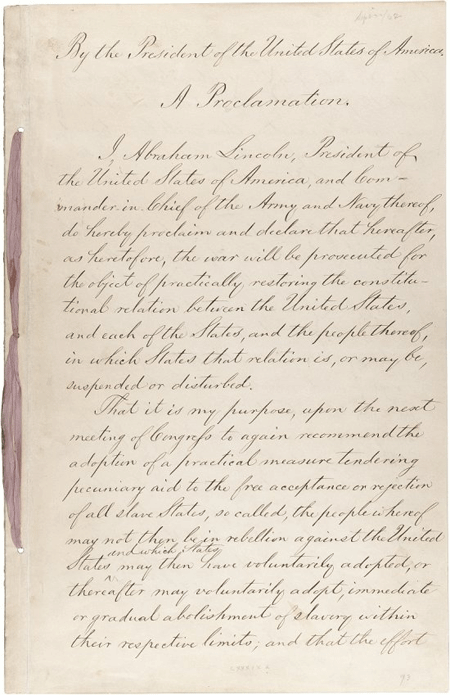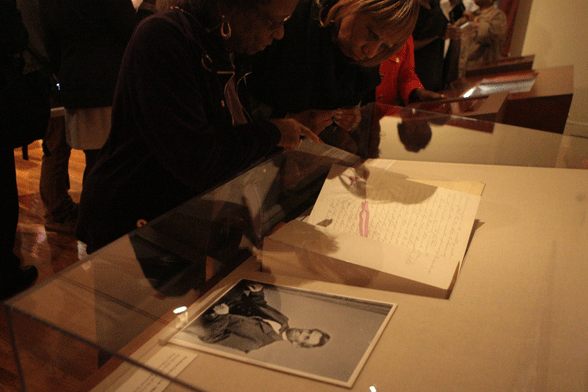Preliminary Emancipation Proclamation on Display
Rare Opportunity to View Preliminary Emancipation Proclamation in Raleigh

The Preliminary Emancipation Proclamation is one of the most significant documents in United States history. President Abraham Lincoln issued the document on Sept. 22, 1862, after the Union victory at Antietam (also called the Battle of Sharpsburg).
Signed by President Lincoln, the Preliminary Emancipation Proclamation ordered that in 100 days the federal government would free all slaves in the states still rebelling against the Union. The document formally alerted the Confederacy of Lincoln’s intention. On Jan. 1, 1863, with the Confederacy still in full rebellion, the president issued the final Emancipation Proclamation.
You have a rare opportunity to see the Preliminary Emancipation Proclamation at the North Carolina Museum of History in Raleigh. On view through Sunday, June 16, 2013, the historical seven-page document is on loan from the National Archives in Washington, D.C. Admission is free.
The Preliminary Emancipation Proclamation is highlighted in the exhibit Freedom Coming, Freedom for All, which is presented by the North Carolina Freedom Monument Park and the North Carolina Museum of History. A second phase of the exhibit, opening July 1, will feature the 13th Amendment.
The exhibit focuses on the status of North Carolina before the Civil War, events leading up to Lincoln’s issuance of the Preliminary Emancipation Proclamation, and outcomes of the document in the state and nation. Freedom Coming also examines the differences among the Preliminary Emancipation Proclamation, the final Emancipation Proclamation and the 13th Amendment.
Phase Two of Exhibit Highlights 13th Amendment
Freedom Coming will reopen with a second phase on Monday, July 1. Phase two features original copies of the 13th Amendment, which outlawed slavery in the United States (except for punishment for crime) and nullified the antebellum slave codes (laws). The movie  “Lincoln” centers on this life-changing document.
“Lincoln” centers on this life-changing document.
Phase two will be presented in two parts.
● July 1 through Oct. 6: North Carolina’s original copy of the 13th Amendment will be on view. It will be on loan from the State Archives of North Carolina.
● Oct. 14, 2013, through Jan. 26, 2014: The exhibit will feature a handwritten copy of the 13th Amendment. Col. Henri Crandall, the Adjutant General of Rhode Island, owned the copy that will be on exhibit.
Major sponsors of Freedom Coming are Blue Cross and Blue Shield of North Carolina; Mechanics and Farmers Bank; News & Observer; North Carolina Humanities Council, a statewide nonprofit and affiliate of the National Endowment for the Humanities; North Carolina Mutual Life Insurance Company; PNC; Radio One; and Spectacular Magazine. Additional support is provided by Epiphany Public Relations of N.C., LLC; the North Carolina African American Heritage Commission and the State Archives of North Carolina.
For further information about the Museum of History, call 919-807-7900 or access ncmuseumofhistory.org or Facebook. To schedule tours for groups of 10 or more, sign up online at nccapvisit.org.
PLEASE NOTE: No photography is permitted in the exhibit. Light levels will be low.
# # #
IMAGE CAPTIONS AND CREDITS
Page One: The Preliminary Emancipation Proclamation will be featured in an exhibit opening May 15 at the N.C. Museum of History. On loan from the National Archives in Washington, D.C., the seven-page document was signed by President Abraham Lincoln on Sept. 22, 1862. Pictured: Page one of the Preliminary Emancipation Proclamation. Photo credit: National Archives, Washington, D.C.
Visitors: The N.C. Museum of History will feature the Preliminary Emancipation Proclamation in an exhibit opening May 15. In this photograph, visitors at the Schomburg Center for Research in Black Culture view the historic document on loan from the National Archives, Sept. 21, 2012. Photograph by Terrence Jennings.


